Quick note up top to say that if you’ve got the means please consider donating to Mutual Aid Disaster Relief to help the folks who are affected by the hurricane that just went through Appalachia. MADR has been on the ground doing this work for many, many years and many, many disasters and they are extremely worthy of your dollars if you have been thinking about donating but weren’t sure where to give.
Julia Skinner also put together an incredible list of more specific issues to donate towards: food distribution, animal rescue, harm reduction, among others.
Stay safe and take care of each other, friends.
Hey friends, I am just back from a trip with my mom to western Ireland. Feeling extremely lucky to have been able to do this journey with her - the place her dad’s family was from - which was about five years in the making (we had initially planned it in the spring of 2020).
I think I’ll probably have some more coherent thoughts about it after I’ve had some more time to sit with it, and to sleep off the jet lag. In the meantime I thought it might be fun to send you some little ditties about plants I saw - some known and some new to me - alongside some snippets from what I was reading while I was there, which lined up with my thinking and feeling in some fruitful, if occasionally uncanny, ways.
I want to be a bit cautious. I sense in myself a tendency to romanticize the idea of Ireland, and to project my ideas/delusions/hopes/dreams/etc onto it - gleaned entirely from reading history, literature, and myth, rather than any actual experience of the place until last week. It is obvious but I say it just to ground myself firmly in reality: every place is a tangled knot of context - war, migration, colonization, enclosure, and constant change - that cannot be untangled or cut through clean. In his walking study of Inis Mor, the largest Aran island, Tim Robinson says:
“I have gone hunting for those rare places and times, the nodes at which the layers of experience touch and may be fused together. But I find that in a map such points and the energy that accomplishes such fusions (which is that of poetry, not some vague “interdisciplinary” fervour) can, at the most, be invisible guides, benevolent ghosts, through the tangles of the explicit: they cannot themselves be shown or named.”
So, with that said: let’s look at some plants, which, of course, are not separate from these tangles of the explicit.
First up is hazelnut. One of the places we got to spend some time is the Burren country, which is famous for its glacial land formations, megalithic portal tombs, and ring fort ruins. An invading English general said of it in the 1600s: “a country where there is not water enough to drown a man, wood enough to hang one, nor earth enough to bury him.” Hazelnut trees grow like weeds there.
There is a Celtic legend that I love that involves hazelnuts. Nine hazel trees grow around a particular sacred well and the nuts fall into the water where they are gobbled up by salmon. “The nuts contain inspiration, knowledge and wisdom, concepts not always defined as they would be in the modern world. Knowledge here implies an esoteric, metaphysical perception, something that can only be bestowed, not gained gradually through sustained, unaided effort,” as MacKillop tells it. The Irish hero of legend Fionn mac Cumhaill gains access to this kind of knowledge just by touching one of the salmon with his thumb and then putting the thumb in his mouth.
This next plant is new to me: sea thrift, or Armeria maritima. It’s found in coastal areas all over the northern hemisphere. I noticed it walking on the cliffs next to the ocean, little pink guys poking up, unfazed by the winds.
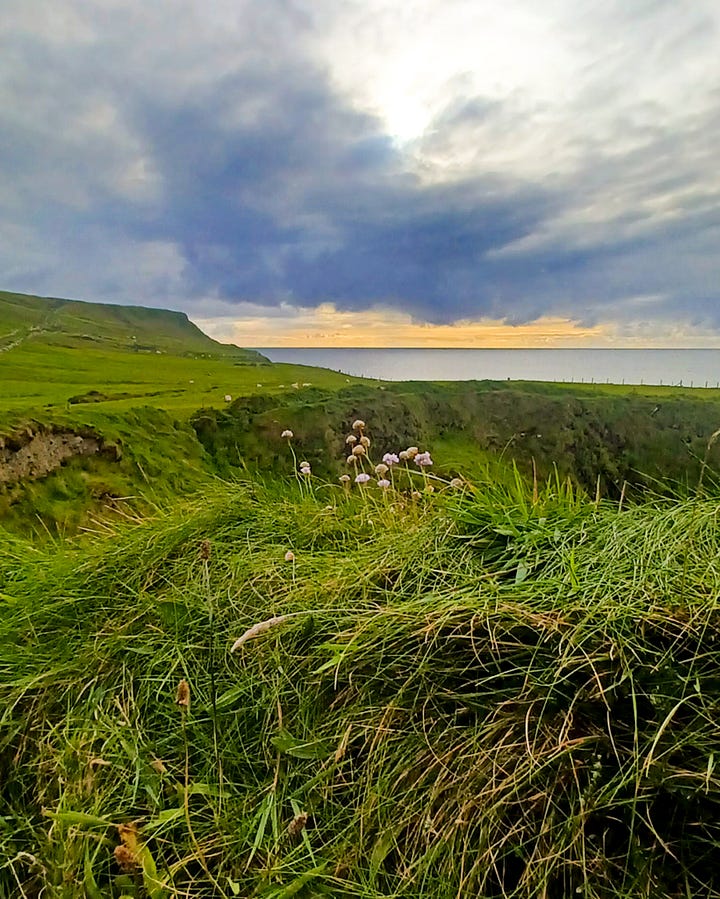
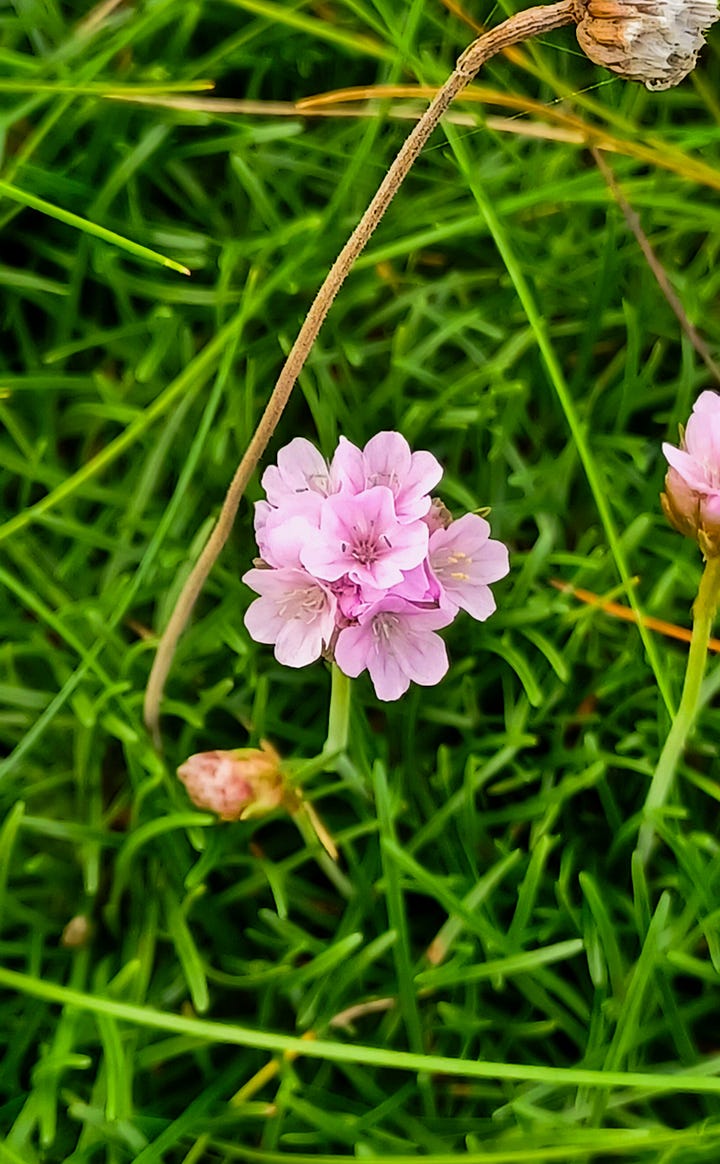
It can thrive not only in lean soils - that’s where the “thrift” comes from, of course - but also in soils where copper concentrations are especially high (which, among other things, can happen over time in soil being heavily used for agriculture). Its other names include: sea pink, lady’s cushion, and cliff rose.
The time walking along and looking upon the Cliffs of Moher was one of the most vertigo-inducing; not just my fear of heights, but also thinking about expanses of time that are difficult to comprehend, and, as Jenny Odell puts it: “Rocks will teach you the inseparability of time and space.” She elaborates: “Rather than avatars passing through an empty calendar square, we are actually on top of the material outcome of processes that span millions of years into both the past and the future. Suddenly, everything we look at is suffused with concrete time: not just the pebbles, crags, and cliffs, but also the fog’s slow movement to the south; each wave’s unrepeatable expression of tides and wind; the frenetic activity of the beach flies; the dispersion of air and water through our bodies; and even the chemicals flashing across our synapses as we think these very thoughts. They, too, will never repeat, and they, too, make the world anew.”1
My appetite is one thing that always keeps me tethered to the present, even when thinking about the deep past, though (so much so that “Mere Getting Hungry” is considered a minor crisis requiring immediate resolution by my partner when we travel together), and I was keeping my eye out for snackable plants on our walks, out of habit if not with the actual intention of foraging. Descending down one part of the cliffwalk, along a little stream, big patches of watercress could tempt a braver walker than I. A densely nutritious member of the mustard family (which you can easily see when you look at its leaves), watercress is an herbal leafy green that’s been used in Irish cooking for eons, and in this region it supposedly was often paired with fish and used in soups.
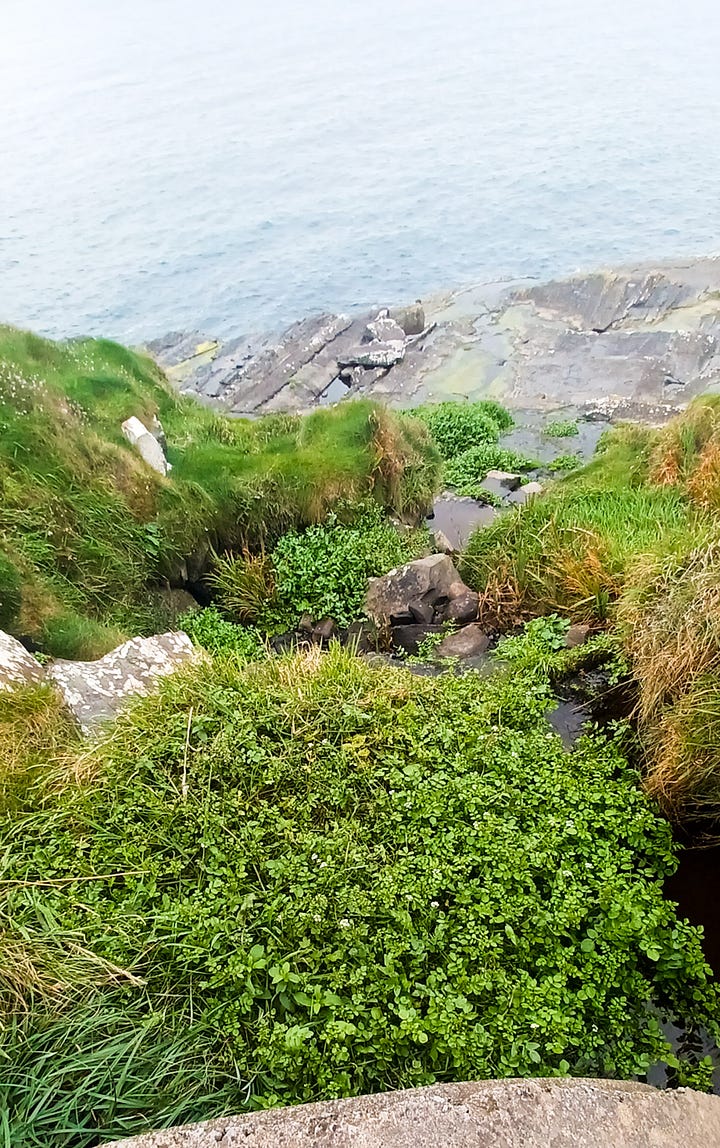
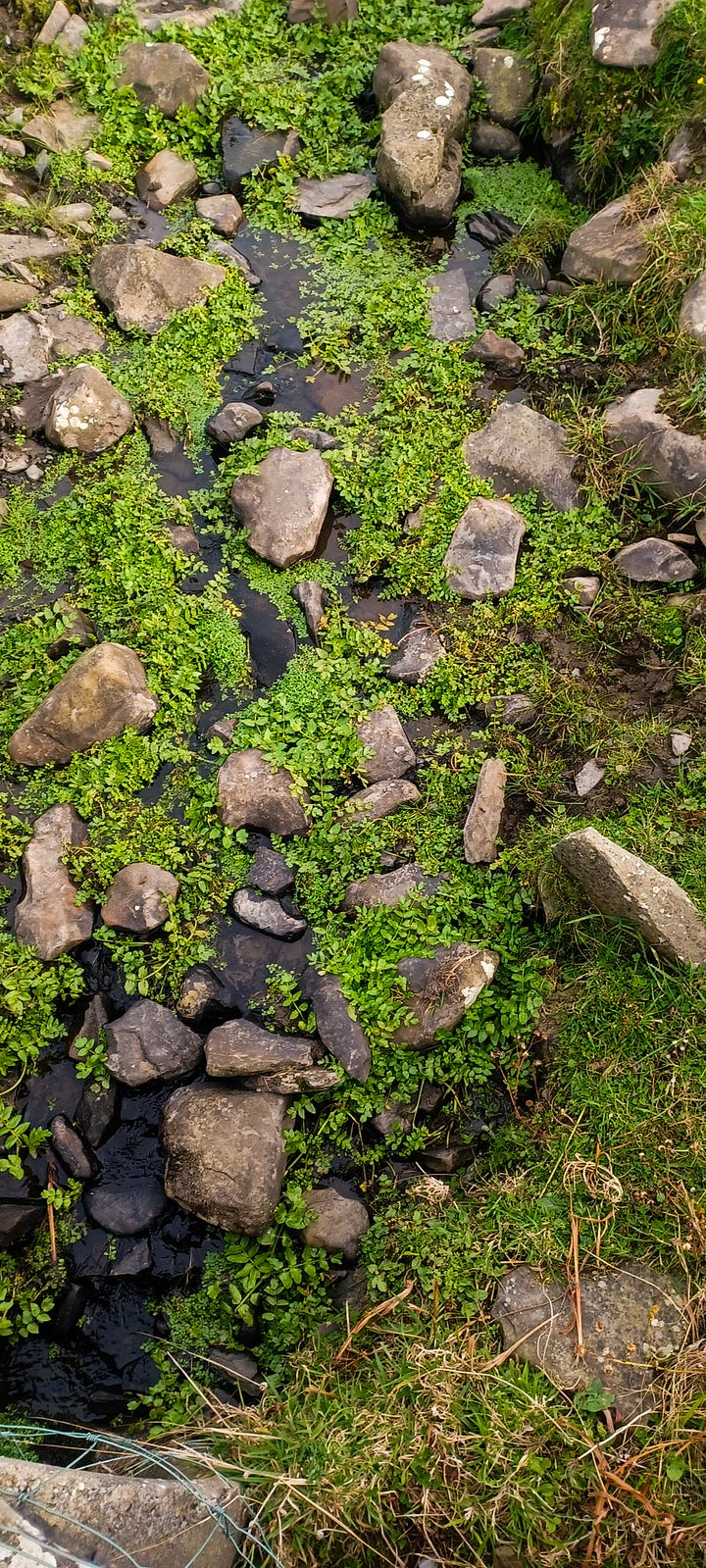
One of the books I brought with me was The Old Ways: A Journey on Foot by Robert Macfarlane; one I was revisiting in hard copy after I loved listening to the audiobook so much. There is a lot in this book that felt resonant to me on this trip - he becomes aquainted with various landscapes and their histories, collapsing time and space again, through the process of journeying through them, with the help of many different guides. The epigraph from Richard Kearney to a chapter on sea roads stuck out for me:
“In antiquity, Irish scholars were known…for their practice of ‘navigatio’…a journey undertaken by boat…a circular itinerary of exodus and return…The aim was to undergo an apprenticeship to signs of strangeness with a view to becoming more attentive to the meanings of one’s own time and place - geographical, spiritual, intellectual.” Yes - yes!!! Let my entire life being an apprenticeship to signs of strangeness in this way. On this trip, one of these signs of strangeness was a series of intense synchronicities - the kind of total chance occurrence that feels fated. It is still tender and close to the bone, so I am sure I will write about this at much greater length some other time, but here’s the outline:
Through a cascading effect of events - terrible weather, snap decisions to change plans, a full ferry, a passing suggestion from a stranger - we ended up on Inis Oirr (anglicized “Inisheer”), the smallest of the Aran islands. Since I had not planned to go there, I had no idea what we would find - at worst, a beautiful place to walk around, we figured. However, Inis Oirr happens to have a shrine to Saint Gobnait, patron of bees and beekeepers to whom I’ve been devoted for the last four years or so, that dates from 10th century - though it was built upon the site of an even earlier church that she founded, I learned. It is still active to this day, by which I mean, people continue to make offerings to her. Her holy well and other sacred sites are mostly in Cork, as far as I knew, so I did not expect to be in this situation - but when you’re confronted with the object of your devotion all you can do is fall down on your knees, right?
Anyway, more on that another time, maybe. One of the plants I found growing out of the thousand year-old walls of her shrine was Kenilworth ivy. The plant ID app on my phone says, “The center of the flowers is yellow to direct or guide the honey bees where the nectar and pollen are.” A fitting plant for the patron saint of the bees. On top of that, its folk usage is for psychic protection and hex-breaking.
It loves to grow on walls, commonly found on ruins like Cill Ghobnait on Inis Oirr in the UK and much of Europe. Its nicknames include Devil’s ribbon, roving Jenny, mother of thousands, climbing sailor, and ivy-leaved toadflax.
I want to end this missive with a poem that found me the day before I left for the trip, by Irish poet Seamus Heaney, which I felt:
Postscript
And some time make the time to drive out west
Into County Clare, along the Flaggy Shore,
In September or October, when the wind
And the light are working off each other
So that the ocean on one side is wild
With foam and glitter, and inland among stones
The surface of a slate-grey lake is lit
By the earthed lightning of a flock of swans,
Their feathers roughed and ruffling, white on white
Their fully grown headstrong-looking heads
Tucked or cresting or busy underwater.
Useless to think you'll park and capture it
More thoroughly. You are neither here nor there,
A hurry through which known and strange things pass
As big soft buffetings come at the care sideways
And catch the heart off guard and blow it open.Thanks for reading & see y’all next time. <3
From Saving Time: Discovering a Life Beyond the Clock by Jenny Odell.

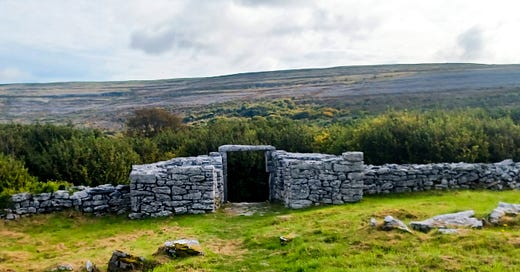




Loved that poem at the end, such a fitting piece for your journey. Looking forward to reading more as you have time to let it all percolate; I really love seeing new plants when I visit new places.